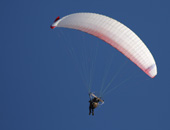Species List | Trip Reports | Home fssbirding.org.uk
Costa de la Luz



15 - 25 April 2009
Observers: F. Simpson
|
|
Species List | Trip Reports | Home fssbirding.org.uk |
|
Costa de la Luz
|
|
|
15 - 25 April 2009 |
|
|
Observers: F. Simpson |
|
Introduction This was another university field course trip based around Zahara de los Atunes on the Costa de la Luz in south-western Spain. Much of the time was spent around Zahara, Barbate and the Valle de Ojén in the Parque Natural de Los Alcornocales. Some time was possible for birding but in general the following notes document the observations at the various study sites. On our free day, a few of use took a boat trip out into the Strait of Gibraltar to observe whales and dolphins. Previous Trip Reports: 2023 | 2019 | 2018 | 2017 | 2016 | 2015 | 2014 | 2013 | 2012 | 2009 | 2008 | 2007 | 2006 | 2005 | 2003
|
Highlights Purple Swamphen · Audouin's Gull · Slender-billed Gull · Short-toed Eagle · Griffon Vulture · Caspian Tern · Thekla Lark Booted Eagle · Crag Martin · Short-toed Lark · Calandra Lark · Pallid Swift · Subalpine Warbler · Black-eared Wheatear · Spoonbill · Lesser Kestrel · Gull-billed Tern · Hawfinch · Western Orphean Warbler · Montagu's Harrier · Bee-eater · Blue Rock Thrush · Melodious Warbler · Purple Heron · Tawny Pipit
|
Literature, references & site guides used 1. Simpson,
F. 2008. Trip Report: Costa de la Luz, 2-12 Apr 2008. |
Itinerary Day 01 15/04/09 London
Gatwick > Málaga > Algeciras > Tarifa > Zahara de los Atunes
|
Day
1 Vía
de Tarifa
Málaga
Airport Málaga
> Algeciras > Tarifa > Zahara de los Atunes Mirador
de el Estrecho Hotel
Gran Sol, Zahara de los Atunes
|
| Day
2 Sand,
sea and snails
| El Señora · Zahara de los Atunes | | Playa de Zahara| Playa
de Zahara (Tentyria, Erodius, Pimelia
beetle study site) Playa
de Atlanterra (Cistus
rockroses
& 2nd beetle study site) La
Zarzuela,
Km-5 on A-2227
(Finca la Negra/Cerro del
Hinojal) (Theba pisana snail study site) Zahara
de los Atunes > Barbate A-2232 road
(2nd Theba study site)
| Griffon Vulture Gyps fulvus | | Kentish Plover Charadrius alexandrinus |
|
| Day
3 A
stream in the cork oak forests
| Barn Swallow Hirundo rustica | | Castello de las Almadrabas · Zahara|
Zahara
de los Atunes Playa
de Zahara Drive
from Zahara to Facinas Puerto
de Ojén,
Parque Natural de Los Alcornocales Arroyo
del Tiradero,
Valle de Ojén,
Parque Natural de Los Alcornocales
5 Iberian Chiffchaff Phylloscopus ibericus ibericus Sonogram of a single verse/strophe of territorial song from a bird singing in open cork oak woodland in the Valle de Ojén, Parque Natural de Los Alcornocales, 17/04/09.
| Valle de Ojén · Los Alcornocales | | Arroyo del Tiradero · Los Alcornocales|
5 Blackcap Sylvia atricapilla Sonogram of territorial song from a bird singing in open cork oak woodland with scrubby understory on asphodel slopes in the Valle de Ojén, Parque Natural de Los Alcornocales, 17/04/09.
|
| Day
4 Lesser
Kestrels in a pueblo blanco
| Vejer de la Frontera | | Vejer doorway|
Zahara
de los Atunes Los
Caños de Meca >
Cabo de Trafalgar | Vejer passage | | Zahara sheep|
Vejer
de la Frontera Atlanterra
>
Faro de Camarinal
|
| Day
5 The
coast of light
| Faro de Camarinal | | Castillo de las Almadrabas flora|
Zahara
> Facinas Puerto
de Ojén,
Parque Natural de los Alcornocales Arroyo
del Tiradero,
Valle de Ojén,
Parque Natural de Los Alcornocales
5 Firecrest Regulus ignicapilla Sonogram of a single verse/strophe of territorial song from a male singing along the border of riverine alder woodland and open cork oak woodland in the Valle de Ojén, Parque Natural de Los Alcornocales, 19/04/09. Composed of repeated notes rhythmically ascending slowly in pitch, c2 seconds in length. Cortijo
Los Villares, Conil de la Frontera
5 Zitting Cisticola Cisticola juncidis Sonogram of territorial song composed of a repetitive single note song uttered in yoyo-ing flight display over waste ground surrounded by wheat fields near Conil de la Frontera.
Breña
de Barbate
|
| Day
6 Looking
for cetaceans between the Pillars of Heracles
| Spanish Festoon Zerynthia rumina | | Bottlenose Dolphin Tursiops truncatus |
Zahara
> Tarifa Castillo de
Guzmán el Bueno, Tarifa Strait
of Gibraltar La
Janda
Track
down to the canal Canal
Colector del Este (Río
Almodóvar) mostly fringed with Phragmites and some mud, depending
on water levels. Main
marsh on the left after 3.1 km from Venta de Retín Lagoons on
the left between 6.4 and 8.0 km from Venta de Retín Presa
de Celemin Benalup Vejer
de la Frontera Playa
de Zahara
|
| Day
7 Return
to the Mediterranean jungle
| Prickly Pear Opuntia fiscus-indica | | Playa de Zahara beach tower|
Arroyo
del Tiradero,
Valle de Ojén,
Parque Natural de los Alcornocales Facinas
> Zahara Arroyo
de la Zarzuela (Zahara
estuary)
| Iberian Water Frog Rana perezi | | Atlanterra · Costa de la Luz |
|
| Day 8
Polistes
paper wasps and prickly pears
| Windfarm & Wildflowers · El Almarchal | | Cabo de Trafalgar sunset |
Castillo
de las Almadrabas, Zahara de los Atunes El
Almarchal Marismas
de Barbate Km-2
on the A-2231 [36º 11' 01.5'' N 05º 53' 07.5''
W] 1m Behind
the Estadio Municipal de
Deportes off Avenida Joaquín Blume
[36º 11' 45.6'' N 05º 54' 41.0''
W] 0m Playa
de Zahara de los Atunes
|
| Day 9
Lizards
in the temple of Isis
| Ocellated Lizard Lacerta lepida | | Harvesting wind and water |
Castillo
de las Almadrabas, Zahara
de los Atunes
5 Blue Rock Thrush Monticola solitarius Sonogram of a verse/strophe of territorial song (low pitched fluty whistles) from the ruined walls of the beachside Castello de las Almadrabas against a noisy backdrop of an awakening House Sparrow roost in nearby palm trees, 0600h, 23/04/09. Breña
de Barbate Barbate Castillo
de las Almadrabas, Zahara
de los Atunes Parque
Eolico Venta
de Retín woodland
5 European Serin Serinus serinus Sonogram of a complex territorial song composed of a constant stream of high-pitched 'electronic noise', Sierra de Retín, 23/04/09.
5 Hoopoe Upupa epops Sonogram of territorial song; trisyllable notes around 0.5 kHz repeated around 28 times/minute. Also a dry, harsh call at 4 seconds, Sierra de Retín, 23/04/09.
5 Hawfinch Coccothraustes coccothraustes Sonogram of sharp, high-pitched, metallic 'pix' calls from a perched bird. N-340
Cadiz > Tarifa road Mirador
near Corijode de la Lapa,
Bolonia Bolonia
Swift Cave | Trajan · Baelo Claudia · Bolonia | | Griffon Vulture Gyps fulvus|
Baelo
Claudia La
Janda Canal
Colector del Este (Río
Almodóvar) mostly fringed with Phragmites and some mud, depending
on water levels. Main
marsh on the left after 3.1 km from Venta de Retín
|
| Day
10 Festooned
in the dawn light
| Spanish Festoon Zerynthia rumina | | Spanish Festoon Zerynthia rumina|
Arroyo
del Tiradero,
Valle de Ojén,
Parque Natural de los Alcornocales I found a roosting Spanish Festoon in the shade and it was clear that some time would pass before the rays of the rising sun would reach the insect in its final resting place from the previous evening. This afforded the perfect photo opportunity of this normally restless and difficult to capture species (see above).
5 Western Bonelli's Warbler Phylloscopus bonelli Sonogram of a single verse/strophe of territorial song; a short trill of just less than 1 second. Bird constantly feeding and moving through the scrub layer of open cork oak woodland while pausing to sing at a rate of 4 phrases/min in the Valle de Ojén, Parque Natural de Los Alcornocales, 24/04/09
5 Sardinian Warbler Sylvia melanocephala Sonogram of territorial song; fast chattering warblers lasting 3-8 seconds mostly uttered from within scrub in the Valle de Ojén, Parque Natural de Los Alcornocales, 24/04/09
|
| Day
11 The
migration continues...
| Stonechat Saxicola torquata | | Avenida de la Playa palms|
Zahara
de los Atunes > Málaga
(via Tarifa) Mijas
|
|
Previous Trip Reports: 2023 | 2019 | 2018 | 2017 | 2016 | 2015 | 2014 | 2013 | 2012 | 2009 | 2008 | 2007 | 2006 | 2005 | 2003
| Costa de la Luz sunset | | Castillo de las Almadrabas |
|
|
All photographs © 2009 F. S. Simpson Fraser's Birding Website · fssbirding.org.uk |